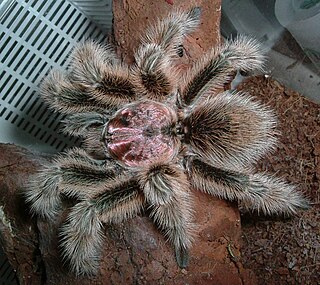
Grammostola is a genus of South American tarantulas that was first described in text by Eugène Louis Simon in 1892. These medium- to large-sized spiders are native to tropical South America, and are usually brown in color, with pinkish or orangish-red hairs. The very docile Chilean rose tarantula is popular as a beginner's spider among tarantula enthusiasts.

Idiopidae, also known as armored or spiny trapdoor spiders, is a family of mygalomorph spiders first described by Eugène Simon in 1889.

Nemesiidae is a family of mygalomorph spiders first described by Eugène Simon in 1889, and raised to family status in 1985. Before becoming its own family, it was considered part of "Dipluridae". The family is sometimes referred to as wishbone spiders due to the shape of their burrows.

The Harpactirinae are a subfamily of tarantulas which are native to the continent of Africa. Like many Old World tarantulas, they have a relatively strong venom and can inflict a painful bite.

Ceratogyrus is a genus of tarantulas found in southern Africa. They are commonly called horned baboons for the foveal horn found on the peltidium in some species.

Euathlus is a genus of South American tarantulas that was first described by Anton Ausserer in 1875. These spiders are medium sized and are usually found in high elevations in the Andes. It is a senior synonym of Paraphysa, and was formerly considered a senior synonym of Brachypelma, but this was later rejected.

Tarantulas comprise a group of large and often hairy spiders of the family Theraphosidae. As of December 2023, 1,100 species have been identified, with 166 genera. The term "tarantula" is usually used to describe members of the family Theraphosidae, although many other members of the same infraorder (Mygalomorphae) are commonly referred to as "tarantulas" or "false tarantulas". Some of the more common species have become popular in the exotic pet trade. Many New World species kept as pets have setae known as urticating hairs that can cause irritation to the skin, and in extreme cases, cause damage to the eyes.

Cyriocosmus is a genus of tarantulas that was first described by Eugène Louis Simon in 1903. They are small to medium spiders, with a bicolored or one same color carapace.

Brachypelma albiceps is a species of spider in the tarantula family, Theraphosidae. It is known as the Mexican golden red rump tarantula or the Amula red rump tarantula. The carapace is a light golden color and the abdomen dark, covered with long red hairs. Females typically live for about 15 years. Males usually live about 5 years or up to 12 months after the last molt.
Anoploscelus is a genus of East African tarantulas that was first described by Reginald Innes Pocock in 1897. It was erected for the species Anoploscelus celeripes, based on a single male collected near Lake Tanganyika in modern day Tanzania. It was synonymized with Phoneyusa from 1985 to 1990. As of December 2019 it contains two species, including A. lesserti, first found in Rwanda in 1946.
Batesiella is a monotypic genus of African tarantulas containing the single species, Batesiella crinita. It was first described by Reginald Innes Pocock in 1903, and is found in Cameroon. It is named in honor of the collector, G. L. Bates. It was synonymized with Encyocrates from 1985 to 1990.
Loxoptygus is a genus of African tarantulas that was first described by Eugène Louis Simon in 1903. As of March 2020 it contains two species, found in Ethiopia: L. coturnatus and L. ectypus. It was removed from the synonymy of Phoneyusa, and is considered a senior synonym of Loxoptygella.
Euphrictus squamosus is a tarantula in the Selenogyrinae subfamily. It is native to the Congo.

Harpactira is a genus of African tarantulas that was first described by Anton Ausserer in 1871.
Ancylotrypa is a genus of African wafer trapdoor spiders that was first described by Eugène Simon in 1889. Originally placed with the Ctenizidae, it was moved to the Cyrtaucheniidae in 1953.
Homostola is a genus of African mygalomorph spiders in the family Bemmeridae. It was first described by Eugène Louis Simon in 1892. Originally placed with the Ctenizidae, it was transferred to the wafer trapdoor spiders in 1985, and to the Bemmeridae in 2020. It is a senior synonym of Stictogaster and Paromostola.
Brachionopus is a genus of South African tarantulas that was first described by Reginald Innes Pocock in 1897. It was transferred to the Theraphosidae from the Barychelidae in 1985.
Hermacha is a genus of mygalomorphae spiders in the family Entypesidae. It was first described by Eugène Louis Simon in 1889. Originally placed with the Ctenizidae, it was transferred to the funnel-web trapdoor spiders in 1985, then to the Entypesidae in 2020. It is a senior synonym of Damarchodes and Hermachola.
Pionothele is a genus of African mygalomorph spiders in the family Pycnothelidae. It was first described by William Frederick Purcell in 1902. As of June 2020 it contains 2 species, found in Namibia and South Africa: P. gobabeb, and P. straminea. Originally placed with the Ctenizidae, it was transferred to the funnel-web trapdoor spiders in 1985, then to the Pycnothelidae in 2020.
Spiroctenus is a genus of African mygalomorph spiders in the family Bemmeridae. It was first described by Eugène Louis Simon in 1889. Originally placed with the Ctenizidae, it was transferred to the funnel-web trapdoor spiders in 1985, and to the Bemmeridae in 2020. It is a senior synonym of Bemmeris, Bessia, and Ctenonemus.









